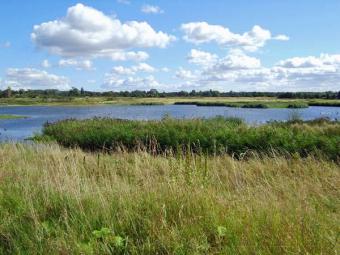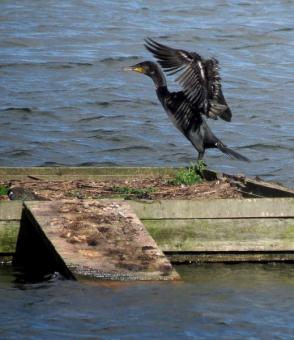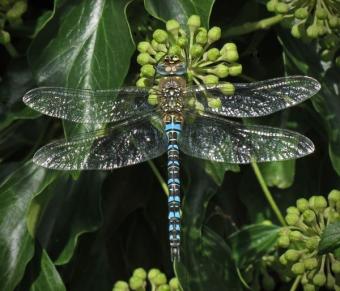 Blue Sky, Blue Lake and A Flock Of LapwingsThis was a superb day out in sunny but windy conditions enjoyed by 13 members of our group. Birds, flowers, dragonflies and butterflies were observed. Margaret outlined the plan for the day which would initially involve looking over Phase 2 of the reserve's development including the ridge and furrow fields and the new hide overlooking a disused gravel pit (now with a lake). Considerable progress had taken place since her last visit in April however it was somewhat disappointing to discover that the waders had not yet arrived.
Blue Sky, Blue Lake and A Flock Of LapwingsThis was a superb day out in sunny but windy conditions enjoyed by 13 members of our group. Birds, flowers, dragonflies and butterflies were observed. Margaret outlined the plan for the day which would initially involve looking over Phase 2 of the reserve's development including the ridge and furrow fields and the new hide overlooking a disused gravel pit (now with a lake). Considerable progress had taken place since her last visit in April however it was somewhat disappointing to discover that the waders had not yet arrived.  Cormorant StretchSand martins were observed around the large viewing hide (very similar to the one recently constructed at Staveley) which will be used for school groups. The hedgerows were looking very attractive aesthetically and hopefully to our avian friends for their supply of winter fuel. The planting was mixed with hawthorn, apple, alder and other species.
A subsequent caculation was made. This was Bees sixth visit since our first visit on 9 Nov 2004 (a diversion from Top Hill Low reservoir which is not available to the public on a Tuesday). The spring flora and birdlife is superb with several species including avocets choosing to breed here. The reserve has attracted some rare and notable species ie black- necked grebe.
On this occasion there was a great gathering of geese; canada and greylag, together with flocks of lapwing and feral pigeons. Also a large flock of goldfinch was seen moving through the hedgerow. 23 bird species were noted. Of particular interest were shoveler, snipe, pochard, pied wagtail (a flock of siskin were heard but not seen on alder by the side of the northern lake).
Cormorant StretchSand martins were observed around the large viewing hide (very similar to the one recently constructed at Staveley) which will be used for school groups. The hedgerows were looking very attractive aesthetically and hopefully to our avian friends for their supply of winter fuel. The planting was mixed with hawthorn, apple, alder and other species.
A subsequent caculation was made. This was Bees sixth visit since our first visit on 9 Nov 2004 (a diversion from Top Hill Low reservoir which is not available to the public on a Tuesday). The spring flora and birdlife is superb with several species including avocets choosing to breed here. The reserve has attracted some rare and notable species ie black- necked grebe.
On this occasion there was a great gathering of geese; canada and greylag, together with flocks of lapwing and feral pigeons. Also a large flock of goldfinch was seen moving through the hedgerow. 23 bird species were noted. Of particular interest were shoveler, snipe, pochard, pied wagtail (a flock of siskin were heard but not seen on alder by the side of the northern lake).
 Migrant HawkerOur lepidopterists would not have been disappointed (they deserve a good outing at last!). Dragonflies were abundant in the more sheltered areas of the reserve including common darter, black darter, migrant hawkers in good numbers and common blue damselfly. The butterflies seen included red admiral, speckled wood, small white, small tortoiseshell and female common blue. Joan was kept busy scribbling down her list of plant species (107 plants in flower and more in seed). Notable flower species included common fiddleneck, musk mallow, common fleabane, common storksbill, smooth hawksbeard and hemlock.
Love Yorkshire, Love North Cave.
Migrant HawkerOur lepidopterists would not have been disappointed (they deserve a good outing at last!). Dragonflies were abundant in the more sheltered areas of the reserve including common darter, black darter, migrant hawkers in good numbers and common blue damselfly. The butterflies seen included red admiral, speckled wood, small white, small tortoiseshell and female common blue. Joan was kept busy scribbling down her list of plant species (107 plants in flower and more in seed). Notable flower species included common fiddleneck, musk mallow, common fleabane, common storksbill, smooth hawksbeard and hemlock.
Love Yorkshire, Love North Cave. Margaret
